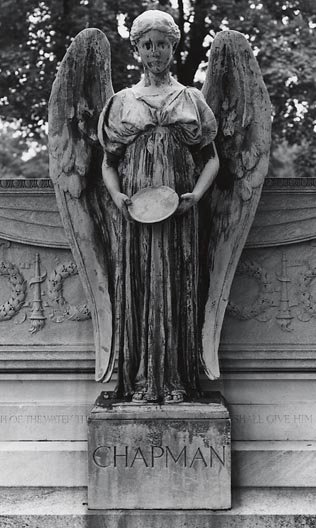
T. A. Chapman Memorial Milwaukee: Visiting Hours, Tickets, and Comprehensive Guide
Date: 03/07/2025
Introduction: The Significance of the T. A. Chapman Memorial
Located within Milwaukee’s historic Forest Home Cemetery, the T. A. Chapman Memorial honors Timothy Appleton Chapman, a pioneering merchant whose vision and resilience helped shape the city’s commercial and civic foundation. Commissioned in 1896 by Chapman’s family, this distinguished bronze sculpture—crafted by Daniel Chester French, renowned for the Lincoln Memorial—serves as a testament to Chapman’s legacy as the founder of Milwaukee’s first upscale department store. The memorial is not only a site of personal and community remembrance but also a fine example of late 19th-century American funerary art. With free public access during daylight hours, proximity to other cultural landmarks, and accommodations for visitors with disabilities, the memorial is a must-visit destination for history enthusiasts, art admirers, and tourists alike. For more details, explore Wikipedia and Touristlink.
Article Overview
- Introduction
- Historical Background
- Origins of the Memorial
- Timothy Appleton Chapman’s Legacy
- Artistic Significance and Symbolism
- The Memorial in Milwaukee’s Heritage
- Visitor Information
- Hours & Admission
- Accessibility
- Directions & Travel Tips
- Nearby Attractions
- Events & Tours
- Preservation Efforts
- FAQ
- Visuals and Media
- Further Exploration
Historical Background
Origins of the T. A. Chapman Memorial
The T. A. Chapman Memorial was commissioned in 1896 by Chapman’s widow and daughters after his death in 1892. Situated at 2405 W. Forest Home Ave. in Milwaukee’s Forest Home Cemetery, this bronze angelic statue was cast by the Henry Bonnard Bronze Company of New York. The memorial is placed prominently in front of the Chapman family crypt, symbolizing both personal loss and public esteem (Touristlink; Alchetron).
Timothy Appleton Chapman: Merchant and Civic Leader
Arriving in Milwaukee in 1857 from Boston, Chapman quickly established himself in the city’s retail sector. He became sole proprietor of a thriving dry goods store by 1865 and, after a devastating fire in 1884, led the rapid rebuilding of his flagship store at Milwaukee Street and Wisconsin Avenue. This five-story landmark, completed in 1885, became a symbol of resilience and innovation (Urban Milwaukee). The Chapman department store continued as a Milwaukee institution for over a century, with the family retaining ownership until 1983 and the flagship store operating until 1981 (Disappointed Tourist; Old Milwaukee).
Artistic Significance and Symbolism
The 62-inch bronze statue by Daniel Chester French features an angel with serene expression, modeled by Jessica Penn Evans. The angel holds a dish symbolizing the “water of life,” reflecting renewal and remembrance. The simplicity of its “CHAPMAN” inscription and the dignified pose speak to both personal legacy and broader themes of continuity and civic pride (Kiddle; Wikipedia). French’s classical motifs and allegorical approach place the memorial within the context of late 19th-century American sculpture.
The Memorial’s Role in Milwaukee’s Heritage
Beyond a grave marker, the T. A. Chapman Memorial encapsulates Milwaukee’s transformation from a frontier town to a dynamic urban center. Chapman’s entrepreneurial spirit and the rebuilding of his store after the 1884 fire exemplify the resilience that defined Milwaukee’s growth. The memorial’s artistic pedigree, with its connection to Daniel Chester French, further cements its importance within the city’s cultural landscape (Alchetron).
Visitor Information
Hours and Admission
- Open: Daily, dawn to dusk (Forest Home Cemetery hours)
- Admission: Free; no tickets required
Accessibility
- Paths and Parking: Paved and wheelchair-accessible near the entrance; some uneven terrain may be encountered within the cemetery
Directions & Travel Tips
- Address: 2405 W. Forest Home Ave., Milwaukee, WI
- Transport: Accessible by car or public transit; parking available near the entrance
- Tips: Wear comfortable shoes and check the weather, as the memorial is outdoors
Nearby Attractions
- Within Forest Home Cemetery: Explore other historic monuments and graves
- Downtown Milwaukee: Milwaukee Public Museum, Milwaukee Art Museum, Historic Third Ward—all within a short drive
Events & Tours
- Guided Tours: Occasionally offered by Forest Home Cemetery; check their website or local event listings for schedules
Preservation and Condition
The T. A. Chapman Memorial, recognized for its artistic and historical value, faces typical challenges of outdoor sculptures—weathering and environmental exposure. As noted by the Smithsonian’s Art Inventories, the statue was last surveyed in 1993 and required conservation at that time (Kiddle). Ongoing preservation is vital to maintain its legacy.
Frequently Asked Questions (FAQ)
Q: What are the visiting hours?
A: The memorial is open daily, dawn to dusk, in accordance with Forest Home Cemetery hours.
Q: Is there an admission fee?
A: No, it is free to visit.
Q: Is the memorial wheelchair accessible?
A: Yes, though some areas may be uneven.
Q: Are guided tours available?
A: Occasionally; check Forest Home Cemetery’s website or event calendars.
Q: What is the best time to visit?
A: Spring through fall for pleasant weather; mornings or late afternoons for photography.
Visuals and Media

Image alt text: T. A. Chapman Memorial, a bronze angel sculpture in Forest Home Cemetery, Milwaukee, WI
Further Exploration
- Explore other Milwaukee Historical Landmarks
- Learn about Forest Home Cemetery Monuments
- Download the Audiala app for guided audio tours and up-to-date event information
Summary and Visitor Recommendations
The T. A. Chapman Memorial is a significant piece of Milwaukee’s historic landscape—a site where art, history, and community spirit converge. Free and accessible, it provides an opportunity to reflect on the city’s evolution and the individuals who shaped it. Whether you visit alone or as part of a guided tour, you’ll gain a deeper appreciation for Milwaukee’s enduring heritage.
For more information and planning resources, consult these trusted sources:
























